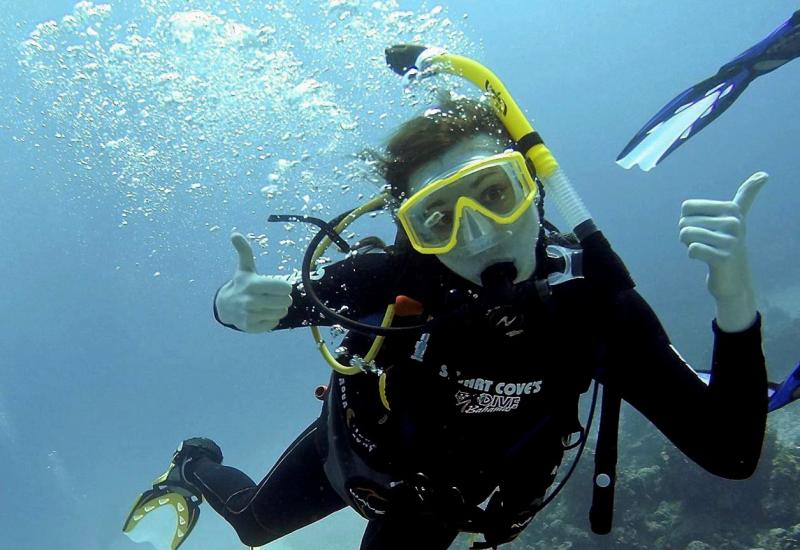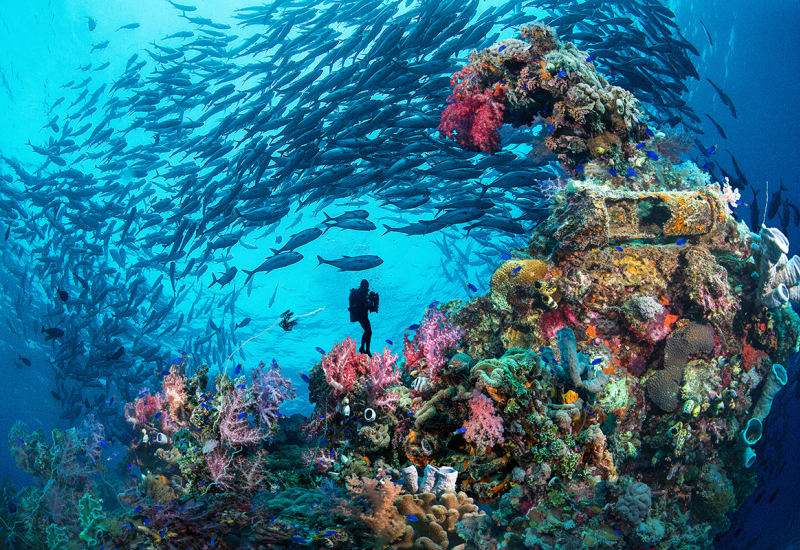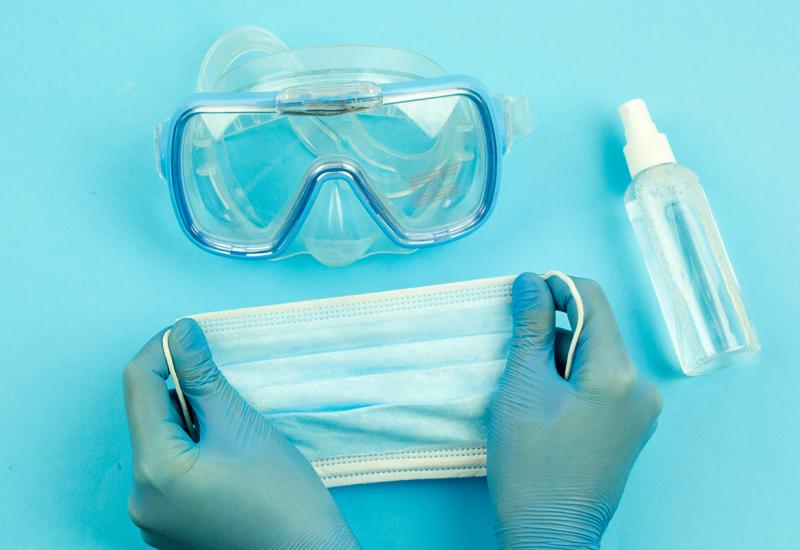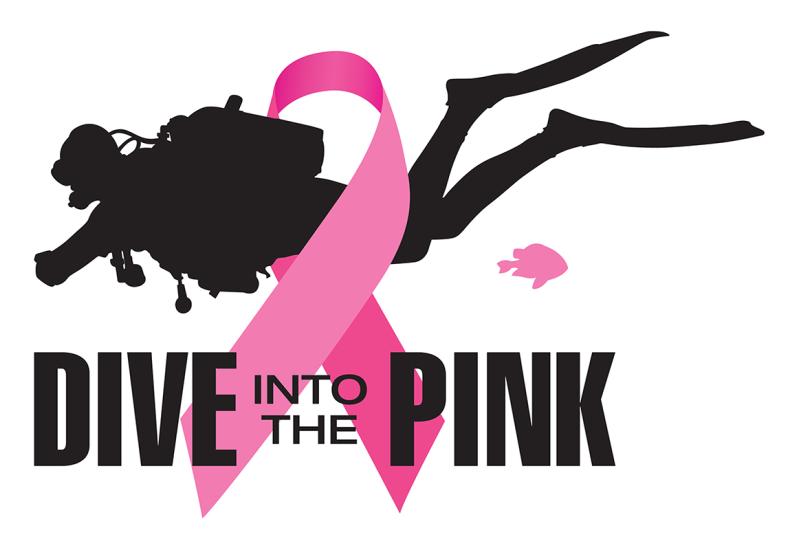Ask An Instructor - July 2008

By Michael Ange
Q: I have an alternate air source that holds roughly 50 additional breaths. In an out-of-air emergency, am I better off making a controlled ascent without a safety stop, or should I attempt a safety stop and then shoot up those last 15 feet?
A: In an out-of-air situation, getting to the surface should be your priority, and compact redundant air sources like yours are specifically designed for a controlled ascent all the way to the surface at the standard rate of 30 feet per minute. Remember, for recreational dives, safety stops, while highly recommended on deeper dives, are not required. Also, do not count on having 50 breaths. Remember that 50 breaths on the surface will only equal 25 breaths at 33 feet (two atmospheres) and only 12 breaths at 99 feet (four atmospheres). And that is the best-case scenario; your test probably didn't simulate the anxiety of truly being out of air underwater. On its web site, the manufacturer of the most common compact emergency air source, Spare Air, recommends making "a practice ascent" from recreational depths so you know how many breaths it will give you.
That said, depending on the depth of your dive and your anxiety level during the ascent, it may be possible to do a limited safety stop if you feel comfortable with it. First, weigh the pros and cons of the situation. If you make a controlled ascent to 15 feet, run out of air on the safety stop and bolt up the last 15 feet, you'll put yourself more at risk than if you simply did a controlled ascent all the way to the surface. This is because the last 15 feet is the area with the greatest change in water pressure and the most likely part of the dive for DCS-causing nitrogen bubbles to occur. So, you'll need to monitor your air supply to avoid running out of air on the safety stop. If your redundant air source has a gauge or indicator, you can watch it and start your ascent from the safety stop with several breaths remaining. But even if you do not have the benefit of an indicator, pay attention to the breathing resistance. When you first notice an increase, you should still have a few breaths remaining as you swim up. A slow ascent of 30 feet per minute will only take 30 seconds from 15 feet, so you should be able to make it to the surface at a comfortable and safe rate. And even if you miss the signs entirely and find yourself out of air, you should be able to ascend slowly to the surface by staying calm and swimming slowly. Just make sure you don't hold your breath. Practice this in shallow water, and you'll be surprised at how slowly you can ascend from 15 feet, exhaling all the way. After practicing these skills a few times, you should be able to make a limited safety stop and still finish with a slow ascent to the surface.
Q: Is there a mathematical way to figure out how much weight I need for diving?
A: There are so many variables that can affect a diver's buoyancy beyond his or her physical attributes--including the exposure suit worn and the type of BC used--that the honest answer to your question is no. The only way to verify your buoyancy is by getting in the water and checking it. Here's how: Start with the amount of weight you think you should wear--instructors often tell new divers to start with 8 to10 percent of their body weight. Then get in the water with your BC deflated and your regulator in your mouth. Holding your breath with your lungs full of air, you should float at about eye level. When you exhale all the air from your lungs, you should slowly sink below the surface. If you sink while holding your breath, you've got too much weight on, and you should take weight off in 2-pound increments and try again. If you don't sink after exhaling, you should keep trying, adding weight in 2-pound increments.
Q: My doctor does not dive or really know anything about diving. Is there a database that can provide a list of diving doctors? If not, how should I go about finding one?
A: Both the Divers Alert Network (diversalertnetwork.org or 800-446-2671) and the Undersea and Hyperbaric Medical Society (uhms.org or 800-533-UHMS) can help you locate your nearest diving physician. The UHMS actually conducts courses to qualify doctors for screening divers.
Q: I recently bought all of my own scuba gear. How often should I have it serviced?
A: The general recommendation for all life-support gear--especially regulators and BCs--is once every year. Manufacturer's suggestions do vary however, so you should check those recommendations in the owner's manuals for your equipment or on the manufacturers' web sites. Another good resource for service details is your dealer. You should service your equipment on schedule even if it is not used much. In fact, many technicians are more concerned about unused gear being serviced than heavily used gear. The soft parts, like O-rings, break down over time. The same is also true for your hoses, although they deteriorate much more slowly. The metal parts of your regulator can also suffer substantial damage from salt, sand and other contaminants that you may not remove with normal post-dive rinsing, and the longer these contaminants sit, the more substantial the damage done. With extended periods of neglect, you may need to replace hard parts of a regulator that would normally last for many years.
Another good reason to service your gear on schedule is to maintain the warranty. Most brands offer warranties of several years or even the lifetime of the equipment, but only if the gear is maintained. Some brands are very restrictive and missing the service schedule by just a few months can void your warranty.
Q: I'm taking scuba lessons now and have a problem with water going up my nose when I practice clearing my mask. Any tips?
A: This is a common problem, and it basically comes from relying on the mask to keep water out of your nose. The real purpose of a mask is to create an air pocket in front of your eyes so you can see, not to keep water out of your nose. You can retrain your thinking by doing exercises that teach you to dive sans mask. First, in a controlled, shallow-water environment (4 to 5 feet), kneel on the bottom and breathe from your regulator with no mask. Stay down for at least two minutes, and don't hold your nose. If you have difficulty, concentrate on breathing in with your mouth and out with your nose--this will help to keep the water out of your nose. After you've mastered stationary no-mask breathing, try swimming around without a mask. Keep at it until you're as comfortable diving without your mask as you are with it. Then try your mask clearing practice again; you should find it much easier.
Q: For most of my diving career I've used steel, 100-cubic-foot, 3500-psi tanks. But as my air consumption has improved, I've started considering new tanks. I'm leaning toward steel 80s, but I've noticed two types of steel tanks, low-pressure (2,400-psi) and high-pressure (3,442-psi). Can you explain the pros and cons of each style?
A: Low-pressure tanks have historically come in three varieties, 2,250-, 2,400- and 2,640-psi. These tanks actually pre-date all the high-pressure tanks, including standard aluminum 80s. The 2,250-psi tanks slipped by the wayside many years ago and, aside from a few relics that show up occasionally, are not currently available. Most of the 2,640-psi cylinders on the market are actually 2,400-psi cylinders rated for a 10-percent overfill. As you noted, the other options are high-pressure cylinders, which range in size from 65 to 130 cubic feet. But consider this: In some areas of the U.S., more so in other parts of the world, many facilities still have 3,000-psi compressors, so if you have a steel 100 rated at 3,442 psi but only fill it to 3,000 psi, you'll only get about 87 cubic feet of gas. Because I travel to a variety of sites, I prefer low-pressure cylinders simply because I can always get a complete fill. If this isn't a concern for you, then the primary considerations are weight, buoyancy and balance.
Many divers think the lightest tank to handle is always the best, so they purchase high-pressure 80s. These are compact and relatively lightweight. However, a taller diver may find it difficult to achieve proper trim in the water because the weight of the tank sits between the shoulder blades instead of down the length of the torso. Conversely, shorter divers may find that these tanks hang too low, typically making their feet too heavy and causing a poor swimming profile.
High-pressure tanks also tend to become neutrally buoyant or slightly positive as they get close to empty, requiring more weight. Low-pressure steel cylinders are generally larger and heavier on the surface, but they remain negative even when empty. This lets you to eliminate some lead, and some divers find this helps them achieve better trim in the water.
Q: I've seen bifocal-type mask inserts that I hope can help me see my gauges and camera while diving. My reading glasses are +2.00. Do I need weaker inserts for my mask because of the magnification of the water?
A: The water does provide some magnification but it is best not to rely on this as a part of your vision correction. If you have a very weak prescription (+0.25) you may not need corrective lenses at all, but otherwise, it's best to go with your standard prescription; this will also allow you to check your equipment on the surface without needing to submerge. These "gauge-reader" inserts are generally inexpensive but you often don't have much choice in the magnification power of the inserts. If you just need assistance reading gauges or seeing a digital camera, this should work fine, but if you find that you need stronger corrective lenses, companies like Sea Vision make bifocal-style lenses with extra magnification at the bottom of the lens. The top half of the lens can have different magnification strengths or just a standard glass lens depending upon your needs.
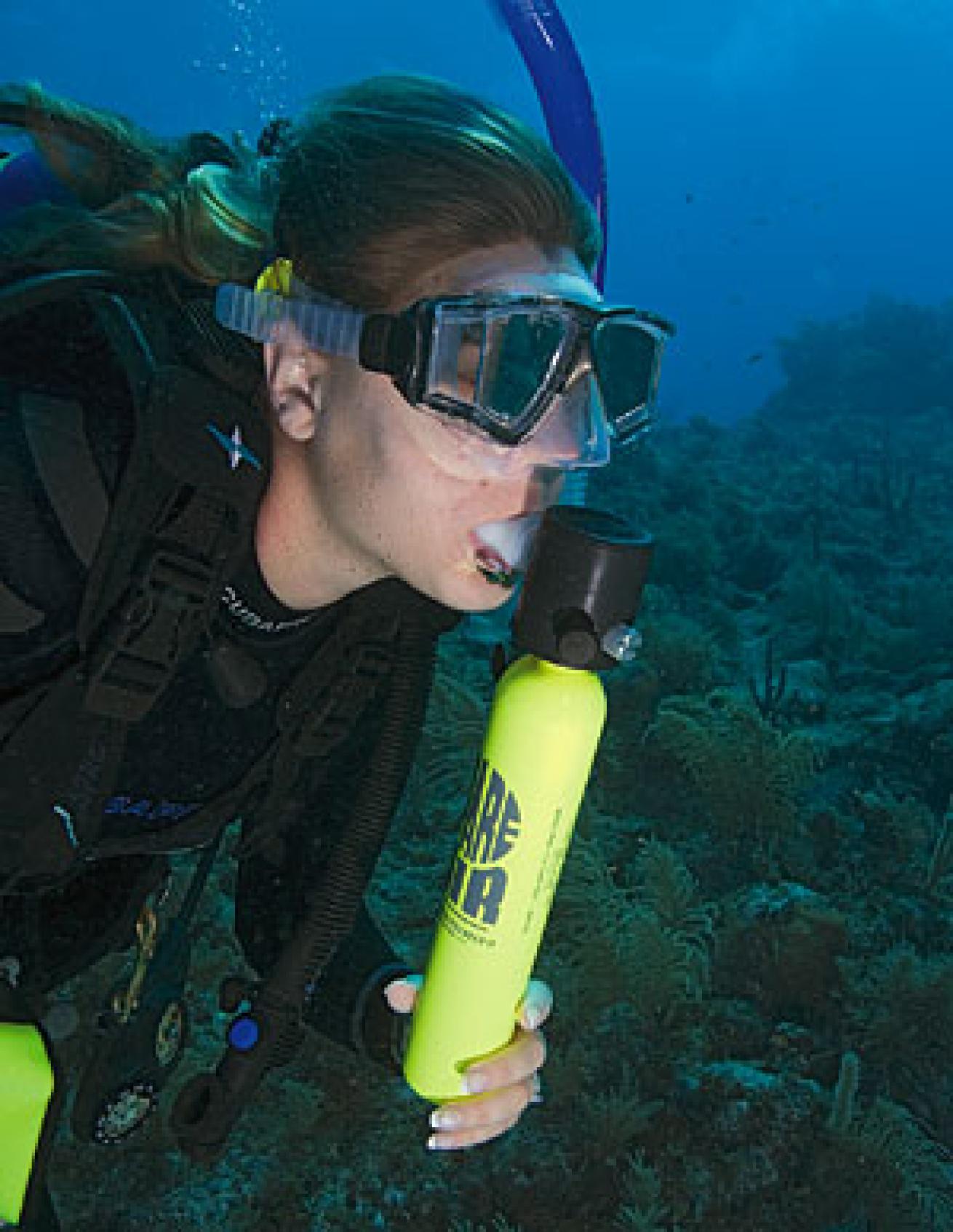
By Michael Ange
Q: I have an alternate air source that holds roughly 50 additional breaths. In an out-of-air emergency, am I better off making a controlled ascent without a safety stop, or should I attempt a safety stop and then shoot up those last 15 feet?
A: In an out-of-air situation, getting to the surface should be your priority, and compact redundant air sources like yours are specifically designed for a controlled ascent all the way to the surface at the standard rate of 30 feet per minute. Remember, for recreational dives, safety stops, while highly recommended on deeper dives, are not required. Also, do not count on having 50 breaths. Remember that 50 breaths on the surface will only equal 25 breaths at 33 feet (two atmospheres) and only 12 breaths at 99 feet (four atmospheres). And that is the best-case scenario; your test probably didn't simulate the anxiety of truly being out of air underwater. On its web site, the manufacturer of the most common compact emergency air source, Spare Air, recommends making "a practice ascent" from recreational depths so you know how many breaths it will give you.
That said, depending on the depth of your dive and your anxiety level during the ascent, it may be possible to do a limited safety stop if you feel comfortable with it. First, weigh the pros and cons of the situation. If you make a controlled ascent to 15 feet, run out of air on the safety stop and bolt up the last 15 feet, you'll put yourself more at risk than if you simply did a controlled ascent all the way to the surface. This is because the last 15 feet is the area with the greatest change in water pressure and the most likely part of the dive for DCS-causing nitrogen bubbles to occur. So, you'll need to monitor your air supply to avoid running out of air on the safety stop. If your redundant air source has a gauge or indicator, you can watch it and start your ascent from the safety stop with several breaths remaining. But even if you do not have the benefit of an indicator, pay attention to the breathing resistance. When you first notice an increase, you should still have a few breaths remaining as you swim up. A slow ascent of 30 feet per minute will only take 30 seconds from 15 feet, so you should be able to make it to the surface at a comfortable and safe rate. And even if you miss the signs entirely and find yourself out of air, you should be able to ascend slowly to the surface by staying calm and swimming slowly. Just make sure you don't hold your breath. Practice this in shallow water, and you'll be surprised at how slowly you can ascend from 15 feet, exhaling all the way. After practicing these skills a few times, you should be able to make a limited safety stop and still finish with a slow ascent to the surface.
Q: Is there a mathematical way to figure out how much weight I need for diving?
A: There are so many variables that can affect a diver's buoyancy beyond his or her physical attributes--including the exposure suit worn and the type of BC used--that the honest answer to your question is no. The only way to verify your buoyancy is by getting in the water and checking it. Here's how: Start with the amount of weight you think you should wear--instructors often tell new divers to start with 8 to10 percent of their body weight. Then get in the water with your BC deflated and your regulator in your mouth. Holding your breath with your lungs full of air, you should float at about eye level. When you exhale all the air from your lungs, you should slowly sink below the surface. If you sink while holding your breath, you've got too much weight on, and you should take weight off in 2-pound increments and try again. If you don't sink after exhaling, you should keep trying, adding weight in 2-pound increments.
Q: My doctor does not dive or really know anything about diving. Is there a database that can provide a list of diving doctors? If not, how should I go about finding one?
A: Both the Divers Alert Network (diversalertnetwork.org or 800-446-2671) and the Undersea and Hyperbaric Medical Society (uhms.org or 800-533-UHMS) can help you locate your nearest diving physician. The UHMS actually conducts courses to qualify doctors for screening divers.
Q: I recently bought all of my own scuba gear. How often should I have it serviced?
A: The general recommendation for all life-support gear--especially regulators and BCs--is once every year. Manufacturer's suggestions do vary however, so you should check those recommendations in the owner's manuals for your equipment or on the manufacturers' web sites. Another good resource for service details is your dealer. You should service your equipment on schedule even if it is not used much. In fact, many technicians are more concerned about unused gear being serviced than heavily used gear. The soft parts, like O-rings, break down over time. The same is also true for your hoses, although they deteriorate much more slowly. The metal parts of your regulator can also suffer substantial damage from salt, sand and other contaminants that you may not remove with normal post-dive rinsing, and the longer these contaminants sit, the more substantial the damage done. With extended periods of neglect, you may need to replace hard parts of a regulator that would normally last for many years.
Another good reason to service your gear on schedule is to maintain the warranty. Most brands offer warranties of several years or even the lifetime of the equipment, but only if the gear is maintained. Some brands are very restrictive and missing the service schedule by just a few months can void your warranty.
Q: I'm taking scuba lessons now and have a problem with water going up my nose when I practice clearing my mask. Any tips?
A: This is a common problem, and it basically comes from relying on the mask to keep water out of your nose. The real purpose of a mask is to create an air pocket in front of your eyes so you can see, not to keep water out of your nose. You can retrain your thinking by doing exercises that teach you to dive sans mask. First, in a controlled, shallow-water environment (4 to 5 feet), kneel on the bottom and breathe from your regulator with no mask. Stay down for at least two minutes, and don't hold your nose. If you have difficulty, concentrate on breathing in with your mouth and out with your nose--this will help to keep the water out of your nose. After you've mastered stationary no-mask breathing, try swimming around without a mask. Keep at it until you're as comfortable diving without your mask as you are with it. Then try your mask clearing practice again; you should find it much easier.
Q: For most of my diving career I've used steel, 100-cubic-foot, 3500-psi tanks. But as my air consumption has improved, I've started considering new tanks. I'm leaning toward steel 80s, but I've noticed two types of steel tanks, low-pressure (2,400-psi) and high-pressure (3,442-psi). Can you explain the pros and cons of each style?
A: Low-pressure tanks have historically come in three varieties, 2,250-, 2,400- and 2,640-psi. These tanks actually pre-date all the high-pressure tanks, including standard aluminum 80s. The 2,250-psi tanks slipped by the wayside many years ago and, aside from a few relics that show up occasionally, are not currently available. Most of the 2,640-psi cylinders on the market are actually 2,400-psi cylinders rated for a 10-percent overfill. As you noted, the other options are high-pressure cylinders, which range in size from 65 to 130 cubic feet. But consider this: In some areas of the U.S., more so in other parts of the world, many facilities still have 3,000-psi compressors, so if you have a steel 100 rated at 3,442 psi but only fill it to 3,000 psi, you'll only get about 87 cubic feet of gas. Because I travel to a variety of sites, I prefer low-pressure cylinders simply because I can always get a complete fill. If this isn't a concern for you, then the primary considerations are weight, buoyancy and balance.
Many divers think the lightest tank to handle is always the best, so they purchase high-pressure 80s. These are compact and relatively lightweight. However, a taller diver may find it difficult to achieve proper trim in the water because the weight of the tank sits between the shoulder blades instead of down the length of the torso. Conversely, shorter divers may find that these tanks hang too low, typically making their feet too heavy and causing a poor swimming profile.
High-pressure tanks also tend to become neutrally buoyant or slightly positive as they get close to empty, requiring more weight. Low-pressure steel cylinders are generally larger and heavier on the surface, but they remain negative even when empty. This lets you to eliminate some lead, and some divers find this helps them achieve better trim in the water.
Q: I've seen bifocal-type mask inserts that I hope can help me see my gauges and camera while diving. My reading glasses are +2.00. Do I need weaker inserts for my mask because of the magnification of the water?
A: The water does provide some magnification but it is best not to rely on this as a part of your vision correction. If you have a very weak prescription (+0.25) you may not need corrective lenses at all, but otherwise, it's best to go with your standard prescription; this will also allow you to check your equipment on the surface without needing to submerge. These "gauge-reader" inserts are generally inexpensive but you often don't have much choice in the magnification power of the inserts. If you just need assistance reading gauges or seeing a digital camera, this should work fine, but if you find that you need stronger corrective lenses, companies like Sea Vision make bifocal-style lenses with extra magnification at the bottom of the lens. The top half of the lens can have different magnification strengths or just a standard glass lens depending upon your needs.

